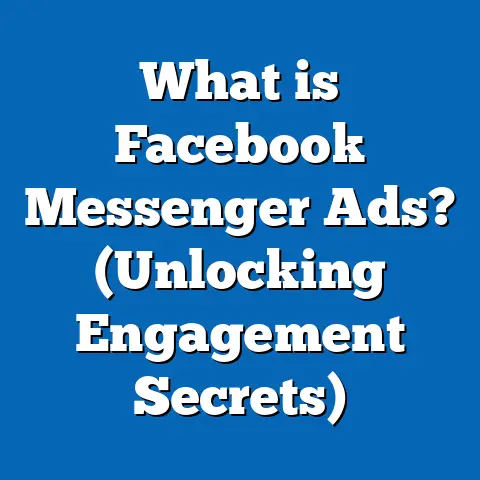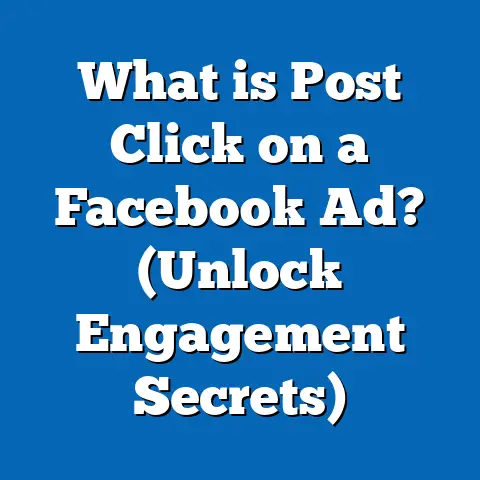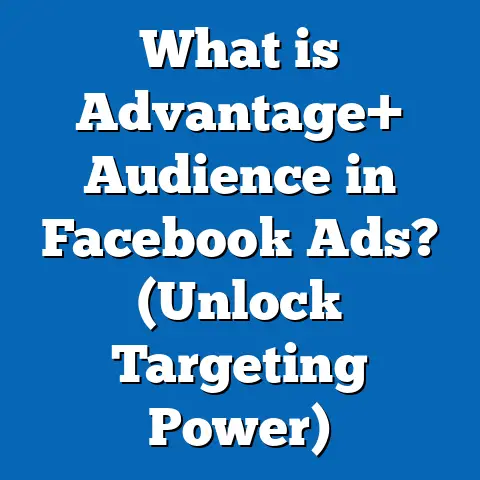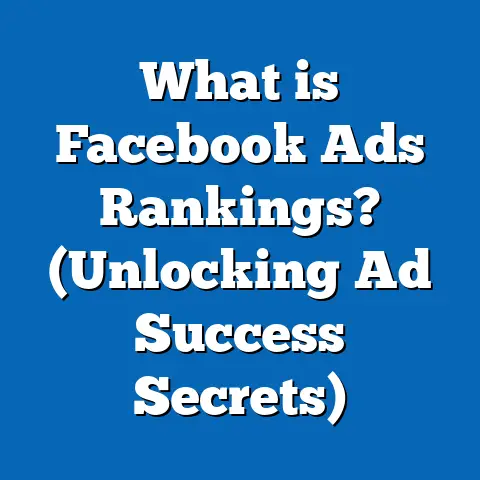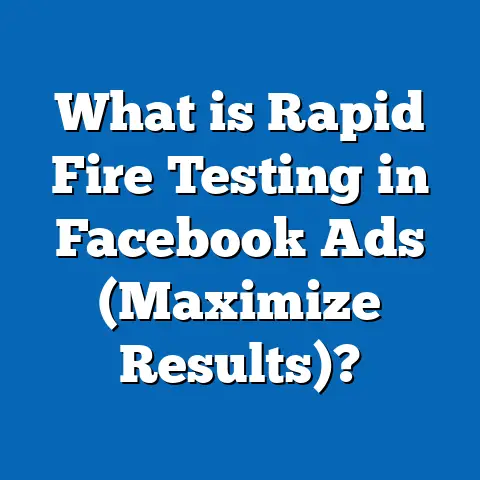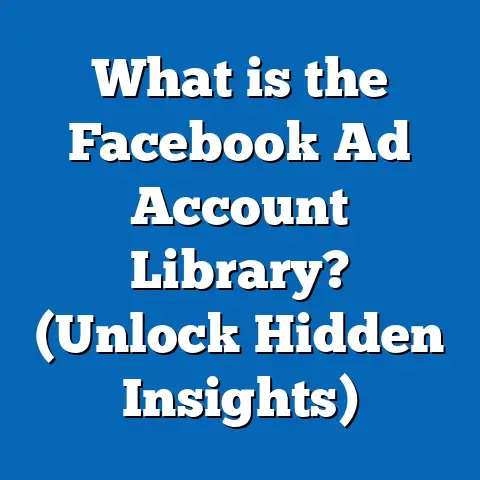What is the Primary Action in Facebook Ads? (Unlocking Conversions)
How to Unlock Conversions: Understanding the Primary Action in Facebook Ads
In the fast-evolving world of digital marketing, Facebook advertising remains an essential tool for businesses seeking to attract, engage, and convert their target audience. However, with millions of businesses competing for attention, simply running ads is not enough. To truly unlock conversions and maximize return on ad spend (ROAS), marketers must understand the concept of the Primary Action in Facebook ads.
This guide will show you how to identify, set up, and optimize your Primary Action to drive more meaningful engagement and sales. We will cover everything from foundational definitions to advanced strategies, backed by data, research, and case studies. Whether you’re a seasoned marketer or a business owner new to Facebook advertising, this comprehensive resource will help you unlock the full potential of your campaigns.
What Is the Primary Action in Facebook Ads?
A Clear Definition
The Primary Action in Facebook advertising is the key user response you want to elicit from your ad viewers. It is the specific behavior that moves users closer to your business goal, such as making a purchase, signing up for a newsletter, downloading an app, or contacting your sales team.
Facebook facilitates this through Call-to-Action (CTA) buttons prominently displayed on ads. These CTAs act as digital signposts directing users to take the desired next step.
Why Is the Primary Action Critical?
The Primary Action is pivotal because it simplifies the user journey and aligns your ad’s messaging with measurable outcomes. Facebook’s algorithm uses this action to optimize ad delivery towards users most likely to perform it.
Data from Facebook indicates that ads with well-defined CTAs can improve conversion rates by up to 20%, making it a vital component for campaign success.
Examples of Common Primary Actions
| Primary Action | Typical Use Case | Facebook CTA Button Examples |
|---|---|---|
| Purchase | E-commerce sales | Shop Now, Buy Now |
| Lead Generation | Collecting emails or registrations | Sign Up, Subscribe |
| Traffic | Directing users to websites or blogs | Learn More |
| App Installs | Promoting mobile app downloads | Download |
| Engagement | Encouraging messages or calls | Contact Us, Send Message |
How Facebook Uses Your Primary Action to Optimize Ads
The Role of Facebook’s Algorithm
Facebook’s advertising platform relies heavily on machine learning and artificial intelligence to deliver ads effectively. When you select a Primary Action, Facebook’s system tailors ad delivery to users who have demonstrated similar behaviors in the past.
For example, if you target “Sign Up” as your Primary Action, Facebook prioritizes showing your ad to users who have historically signed up for newsletters or offers.
This results in:
- Higher likelihood of conversions
- Lower cost per acquisition (CPA)
- Improved return on ad spend (ROAS)
Conversion Events and Facebook Pixel
The Facebook Pixel is a piece of code placed on your website or app that tracks user actions related to your ad campaigns. These tracked actions are called conversion events and include things like:
- Page views
- Add to cart
- Purchases
- Lead forms submitted
By linking these events to your Primary Action, Facebook can better optimize who sees your ads based on real-time performance data.
Statistics show that advertisers using conversion tracking with Facebook Pixel see a 25% average increase in conversion rates compared to those who don’t use it.
Step-by-Step Guide: Setting Up Your Primary Action for Success
Step 1: Identify Your Overall Campaign Objective
Your campaign objective sets the foundation for selecting your Primary Action. Facebook offers three categories of objectives:
- Awareness: Brand Awareness, Reach
- Consideration: Traffic, Engagement, App Installs, Video Views, Lead Generation
- Conversion: Conversions, Catalog Sales, Store Traffic
Your Primary Action should directly support this objective. For example, if your goal is sales (Conversion), your Primary Action might be “Shop Now.” If your goal is lead generation, “Sign Up” could be more appropriate.
Step 2: Select the Correct Call-to-Action Button
Facebook provides a list of CTA buttons tailored for different actions:
| Campaign Objective | Best CTA Buttons |
|---|---|
| Sales | Shop Now, Buy Now |
| Lead Generation | Sign Up, Subscribe |
| Website Traffic | Learn More |
| App Promotion | Download |
| Customer Engagement | Contact Us, Send Message |
Choosing the right button reduces confusion and increases user trust.
Step 3: Design Ad Creatives Around Your CTA
Your ad’s headline, text, images/videos, and CTA button must work together seamlessly.
- Use action-oriented language: “Start your free trial today,” “Get 50% off now.”
- Incorporate urgency: “Limited time offer,” “Only 3 days left.”
- Ensure visual elements direct attention toward the CTA button.
Step 4: Implement Conversion Tracking
Install and configure the Facebook Pixel on your website or app. Set up custom conversion events aligned with your Primary Action.
Example: If your Primary Action is “Sign Up,” track form submissions as a conversion event.
Testing pixel installation using Facebook’s Event Manager ensures accurate data collection.
Breaking Down Complex Concepts: Conversion Optimization Using Primary Actions
Behavioral Segmentation and Targeting
Facebook allows advertisers to create highly targeted audiences based on interests, behaviors, demographics, and past interactions (retargeting).
For example:
- A health supplement company targeting users interested in fitness can use a “Shop Now” button aimed at those who added similar products to carts previously.
- A webinar company targeting small business owners might use a “Sign Up” button for event registration.
This precision makes your Primary Action more effective by reaching users most likely to act.
A/B Testing Your Primary Actions
A/B testing (split testing) involves creating two or more variations of an ad that differ only by one element—in this case, the CTA button—to determine which performs better.
Example test:
- Ad A uses “Learn More”
- Ad B uses “Sign Up”
Results showed Ad B increased leads by 25% in a B2B campaign.
Running such tests regularly helps you optimize campaigns continuously.
In-depth Case Studies: Real Business Impact from Optimized Primary Actions
Case Study 1: E-Commerce Brand Boosts Sales by Changing CTA
A fashion retailer initially used “Learn More” as their primary CTA on product ads. After switching to “Shop Now,” they experienced:
- 18% increase in conversion rate
- 25% reduction in cost per acquisition
- $50,000 additional revenue within one month
By aligning CTA with purchase intent, they significantly improved ROI.
Case Study 2: SaaS Company Gains More Leads with Sign-Up CTA
A SaaS company promoting a free trial tested different CTAs:
- “Download” vs. “Sign Up”
“Sign Up” generated:
- 22% more leads
- Higher quality leads measured by demo requests (+17%)
This reinforced the importance of clear alignment between CTA and campaign goals.
Case Study 3: Local Restaurant Uses Messaging CTA for Reservations
A restaurant used Ads with “Send Message” CTAs linking to Facebook Messenger. This allowed customers to book tables directly via chat.
Results:
- 35% increase in reservations through ads
- Stronger customer relationships due to direct communication
This shows how non-traditional CTAs can also unlock conversions in service industries.
Comparing Facebook’s Primary Actions with Other Platforms
Google Ads vs. Facebook Ads CTAs
Google Ads primarily targets users based on search intent with text-based ads. CTAs are embedded in ad copy rather than as buttons.
| Feature | Facebook Ads | Google Ads |
|---|---|---|
| CTA Format | Button (Shop Now, Sign Up) | Text-based CTA (Buy Now) |
| Targeting | Behavioral & Interest-based | Intent-based Keyword targeting |
| User Intent | Awareness/Consideration stage | High-intent purchase/search |
Facebook excels at nurturing interest and pushing users down the funnel with engaging visuals and CTAs tailored per objective.
Instagram Ads
Instagram shares many features with Facebook but demands visually captivating content due to its image-first layout.
Key differences include:
- Instagram Stories use “Swipe Up” as their primary action.
- Engagement rates for Instagram ads tend to be 15% higher than Facebook.
Marketers often use Instagram alongside Facebook for complementary targeting and engagement strategies.
Deep Dive: Metrics and Tools To Measure Your Primary Action Effectiveness
Key Metrics Explained
- Click-Through Rate (CTR)
Shows percentage of people who clicked on your CTA after seeing your ad. Higher CTR usually means better ad relevance and design. - Conversion Rate
Percentage of clicks that result in completing the desired action (purchase, sign-up). Critical for measuring ROI. - Cost Per Conversion (CPC/CPA)
Amount spent divided by number of conversions; helps evaluate efficiency. - Return on Ad Spend (ROAS)
Revenue generated divided by ad spend; ultimate measure of profitability. - Engagement Rate
Includes likes, shares, comments; indirectly supports conversion by increasing brand visibility.
Tools for Measurement
- Facebook Ads Manager
Offers detailed breakdowns by demographics, placements, devices. - Facebook Pixel & Event Manager
Tracks website/app user actions tied directly to ads. - Google Analytics
Complements pixel data by analyzing post-click behavior like session duration or bounce rate.
Common Pitfalls When Choosing or Using Your Primary Action
- Vague CTAs: Using generic terms like “Click Here” confuses users.
- Mismatch Between CTA & Objective: Using “Learn More” when your goal is direct sales dilutes effectiveness.
- Ignoring Mobile Optimization: Over 90% of Facebook traffic is mobile; ensure CTA buttons are easy to tap.
- No Conversion Tracking: Without tracking pixels or events properly set up, measuring success becomes guesswork.
- Overloading Ads With Multiple CTAs: Too many choices confuse users; focus on one clear action per ad.
Latest Industry Trends and Features (2024)
AI-Powered CTA Recommendations
Facebook now uses AI to suggest optimal CTAs based on campaign data and audience behavior patterns.
Dynamic CTAs
Ads can automatically adjust their primary action depending on factors like user device or stage in the funnel.
Messenger & WhatsApp Integration
New CTAs like “Send Message” allow direct communication through popular chat apps, increasing engagement opportunities for service-based businesses.
Privacy Changes and Tracking Challenges
With privacy regulations tightening (GDPR, CCPA), Facebook has updated pixel protocols requiring explicit consent but still provides robust tracking when implemented correctly.
Practical Strategies for Optimizing Your Primary Action for Maximum Conversions
- Ensure Consistency Between Ad & Landing Page
The landing page must deliver exactly what the CTA promises. - Use Strong Copywriting Techniques
Include urgency (“Limited offer”), exclusivity (“Only available here”), and benefits (“Save time today”). - Leverage Retargeting
Show tailored CTAs based on previous user activity; e.g., “Complete Your Purchase” for cart abandoners. - Optimize for Mobile Viewing
Use concise text and big buttons that are easy to tap. - Regularly Update Creative Elements
Fresh images/videos keep audiences engaged and can improve performance over time. - Run Multiple Campaigns Focused on Different Funnel Stages
Use different primary actions for awareness (“Learn More”) versus conversion (“Buy Now”).
Summary and Next Steps: Unlocking Conversion Potential Through Primary Actions
Mastering the Primary Action in Facebook ads is essential for turning clicks into measurable business outcomes. Key takeaways include:
- Define clear campaign objectives before choosing your CTA.
- Align your ad creative with a single focused Primary Action.
- Use Facebook Pixel and conversion tracking to gather actionable data.
- Test different CTAs regularly through A/B testing.
- Monitor key metrics like CTR, conversion rate, CPA, and ROAS.
- Stay updated on platform innovations like AI-driven CTAs and messaging integration.
By consistently applying these principles and fine-tuning your approach based on data insights, you can unlock higher conversion rates and greater ROI from your Facebook advertising efforts.

